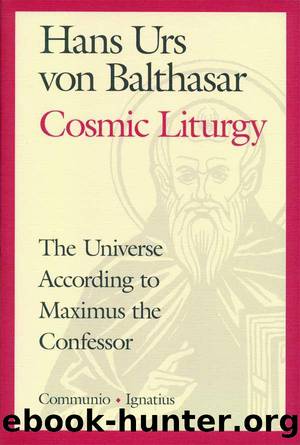Cosmic Liturgy by Hans Urs von Balthasar

Author:Hans Urs von Balthasar [Balthasar, Hans Urs von]
Language: eng
Format: epub
Tags: Spiritual & Religion
ISBN: 9780898707588
Published: 2013-09-14T04:00:00+00:00
4. Healing as Preservation
a. The Exchange of Properties
The Monophysite controversy had a dangerous postlude: Monothelitism. Here the problem was pursued into its farthest corner: the focus of the question was no longer that of natures in general but the more narrow issue of their most âpersonalâ expressions and abilities. In this way, the debate took, at the same time, a turn toward the concrete. It was no longer the formal relationship of nature and person that stood in the foreground but the living exchange (á¼Î½ÏίδοÏιÏ) of them both, realized in the drama of the Incarnation and its catastrophic climax, the Saviorâs Passion. This turn from formal ontology to its concrete and lived experience, from logos to bios, was destined to become also the acid test of Christology.
Maximus builds his whole doctrine of salvation, with great consistency, on the basis of his formal Christology. There the unconfused but continued existence of the two natures provided the foundation for the decisive synthesis. This preservation of the human nature put it, by itself, in the position to place all its positive content, undiminished (á¼Î½ÎµÎ»Î»Î¹Ïá¿¶Ï ÏάνÏÎ±Ï ÏÎ¿á½ºÏ ÏÏ ÏÎ¹Ï°Î¿á½ºÏ Î»ÏÎ³Î¿Ï Ï), at the service of unification,219 as building blocks for the great bridge between God and the world. âPrecisely because Christ was the mediator between God and man, he had to preserve completely his natural kinship with the two poles he brings together, by being them both himself.â220 This does not imply any kind of natural communication between the two: ânature and nature do not share a common nature.â221 âFor it is not by denial of opposition, as some think, that a mediating position is affirmed.â222 In fact, what happened is something unexpected, yet perfectly logical: in the synthesis, the mutual difference of the poles is precisely what is underlined and confirmed, âeach rather confirming the other by means of each otherâ (δι᾿ á¼Ï°Î±ÏÎÏ±Î¿Ï Î´á½² μᾶλλον ÏιÏÏοÏÎ¼ÎµÎ½Î¿Ï Î¸Î¬Ïεϱον).223 It is only then, when God and man come closest to each other and meet in a single person that it becomes obvious before our very eyes that God is eternally, irreducibly other than man and that man may therefore not seek his salvation in a direction that implies an abandonment of his own nature.
For this reason, Chalcedonâs great word was âsaveâ (ÏÏζειν): the preservation of the peculiar character of both natures,224 All the great defenders of the Council made use of it, Leontius225 as well as Sophronius.226 For Maximus, this word becomes the most central concept in the whole order of redemption, for it unites in itself both aspects of Christâs saving work: healing and rescue, on the one hand, and preservation and confirmation, on the other. Insofar as nature is elevated by grace, it is also strengthened and brought to fulfillment within itself. Through manâs participation in God, mankindâmanâs creaturelinessâitself is perfected. The unity of God and man âis achieved through the preservation [of differences], guaranteed by guaranteeing them. For the unification of the two poles comes to full realization to the exact degree that their natural difference remains intact.
Download
This site does not store any files on its server. We only index and link to content provided by other sites. Please contact the content providers to delete copyright contents if any and email us, we'll remove relevant links or contents immediately.
The Lost Art of Listening by Michael P. Nichols(6469)
Why I Am Not A Calvinist by Dr. Peter S. Ruckman(3768)
The Rosicrucians by Christopher McIntosh(3049)
Wicca: a guide for the solitary practitioner by Scott Cunningham(2704)
Signature in the Cell: DNA and the Evidence for Intelligent Design by Stephen C. Meyer(2499)
Real Sex by Lauren F. Winner(2474)
The Holy Spirit by Billy Graham(2413)
To Light a Sacred Flame by Silver RavenWolf(2353)
The End of Faith by Sam Harris(2286)
The Gnostic Gospels by Pagels Elaine(2025)
Nine Parts of Desire by Geraldine Brooks(2005)
Waking Up by Sam Harris(1956)
Heavens on Earth by Michael Shermer(1953)
Devil, The by Almond Philip C(1898)
Jesus by Paul Johnson(1887)
The God delusion by Richard Dawkins(1847)
Kundalini by Gopi Krishna(1823)
Chosen by God by R. C. Sproul(1758)
The Nature of Consciousness by Rupert Spira(1688)
